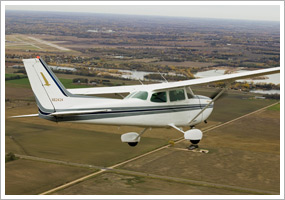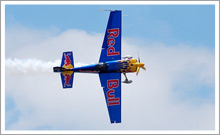| ||||
| | FT News | INSIDE AOPA | TRAINING PRODUCTS | FINAL EXAM | |||
TRAINING TIPsAttention to detail Climbing will put the flight more than 3,000 feet agl, activating the hemispherical rule. The pilot has been flying a heading of 355 degrees to maintain his course in strong westerly winds aloft. He decides on an altitude of even thousands plus 500 feet msl. Is it the right decision? Preparing to enter the traffic pattern at the destination nontowered airport, the pilot monitors the ASOS broadcast, noting clouds, visibility, and surface winds. He missed the altimeter setting and now remembers that it hasn’t been adjusted since departure. He knows from his weather briefing that he is flying toward higher atmospheric pressure, and realizes with relief that the well-known warning, “From high to low, look out below!” won’t apply. Now to enter the traffic pattern. The turbulence has jostled the cockpit quite a bit; both the flight log and airport/facility directory have slipped out of reach. The pilot, to his credit, had already set the common traffic advisory frequency in the number two radio. But what’s the traffic pattern altitude (TPA)? No worries! Down below, the FBO’s hangar is plainly visible with the elevation painted broadly across its roof. Such an ingenious idea. All the pilot has to do is add 1,000 feet and presto—TPA. Or is it? Let’s take a brief look at each of these real-world scenarios and examine the pilot’s assumptions for any errors. When selecting the cruising altitude, it’s possible that the pilot’s choice of even thousands plus 500 feet msl would be wrong. The tipoff is that the pilot is correcting for winds from the west. If the magnetic course being tracked in that strong wind is east of magnetic north, odd thousands plus 500 feet would be the correct choice. Casual application of “from high to low, look out below,” reassured the pilot that he wasn’t flying lower than his altimeter’s reading—but that’s not the only factor to consider. For example, when entering the traffic pattern, being higher than you think would be unsafe. Speaking of the pattern, selecting 1,000 feet agl is a good guess—but not always correct. Some airports have nonstandard or multiple TPAs. Check before you go. YOUR PARTNER IN TRAININGCommunicating effectively on the radio is an important skill to master. No wonder some of us get sweaty palms when we have to click the push-to-talk button! The Air Safety Institute’s Say It Right: Mastering Radio Communication online course will give you practical tips to make you sound professional and at ease. Say It Right and many other interactive courses are available free to all pilots. Search the selection at the Air Safety Institute website.
Did you know that student pilots who join AOPA are three times more likely to complete their flight training? Membership includes unlimited access to aviation information by phone (800/USA-AOPA, weekdays from 8:30 a.m. to 6 p.m. Eastern time) or from Flight Training Online or AOPA Online. If you're not already a member, join today and get the pilot’s edge. Login information is available online. FLIGHT TRAINING NEWSChanges proposed to crew training rulesThe FAA on May 11 announced supplemental proposed changes to air carrier crew training rules. The supplemental notice of proposed rulemaking addresses comments made to the January 2009 proposal. Among other changes, it would require ground and flight training to teach pilots how to recognize and recover from stalls as well as aircraft upsets. It would also require remedial training for pilots who have failed proficiency flight tests or checks, or unsatisfactory performance during flight training or a simulator course. ASA offers free training syllabiAviation Supplies and Academics has made available as a free download two training publications: Pilot’s Manual: Private Pilot Syllabus and Pilot’s Manual: Instrument Rating Syllabus. Flight lessons for both books are presented side by side with coordinating ground lessons. Both publications meet FAR 61 and 141 requirements. The books are available as PDF files; soft-cover books can be ordered for $12.95 each. NBAA scholarships open for businessThe National Business Aviation Association is accepting applications for several academic scholarship opportunities from now until July 29. Sample offerings include the Lawrence Ginocchio Aviation Scholarship, which awards $4,500 annually to each of five students enrolled in a NBAA/University Aviation Association membership institution. For more information, see the website. Don’t be surprised at checkride timeFollowing the FAA’s practical test standards for your checkride means more than precise stick-and-rudder skills. It also means demonstrating other pilot-in-command responsibilities, such as performing a proper preflight inspection and showing good decision-making skills. All of the items you could be tested on, along with many helpful tips for passing your checkride, are available in the Pilot’s Checkride Guide from the Air Safety Institute. Keep a copy with you and you’ll never be without a reference to your upcoming big event. Summer camp for the grown-up pilotsYou’re sending your kids off to camp, but have you considered a summer camp option for yourself? Sporty’s is offering its first-ever Summer Camp for Pilots, Aug. 11 through 14 at Clermont County Airport in Ohio. You can get a flight review or an instrument proficiency check, learn about and fly glass-cockpit-equipped aircraft, and more. Dual instruction will be available with a Sporty’s Academy flight instructor in your aircraft or in a Sporty’s aircraft. For more information, see the website. Inside AOPAAviation community can help improve flight trainingAnyone who has ever taken flight lessons can help improve the training process by sharing his or her input in one of a series of regional meetings that kicks off May 24 in Fairfield, N.J. AOPA launched the Flight Training Student Retention Initiative in 2010 to help increase the percentage of students who earn a pilot certificate. From May through September this year, the association is following up on the comprehensive, independent study it commissioned on the flight training experience with meetings in six metro areas around the United States. Read more >> Will you do the right thing?Let’s face it: Making good decisions in flying is not always a cut-and-dried process. In reality it requires you to continuously anticipate, recognize, act, and evaluate—from preflight through landing. Sounds complicated? The Air Safety Institute’s interactive online course Do the Right Thing: Decision Making for Pilots guides you through the process of tough decision making with down-to-earth information, tips, and interactive scenarios where you decide the outcome. Your objective? Boost this critical skill and learn to make good choices every time you fly. Take the course >> Make sure you’re covered“You’re not covered!” No pilot wants to hear this after an accident with a rented or borrowed aircraft, but many pilots could hear those words because they did not have aircraft renter’s insurance. Many who rent aircraft mistakenly believe they are covered by their flight school’s or FBO’s policy. Don’t count on it. Read more >> The facts behind FAA enforcementAlmost anyone flying in today’s complex aviation environment is acutely aware that there are regulations, manuals, orders, circulars, bulletins, and directives that must be consulted, followed, and complied with when operating an aircraft. This is a regulatory responsibility as well as a practical safety responsibility. But, how many of us are as acutely aware of the consequences of failing to follow them? Read more >> TRAINING PRODUCTSSOL Origin survival kits from Pilotmall.comDo you carry survival and first-aid gear when you fly? Small, easily transportable kits could be a welcome addition to your cockpit should you experience an off-airport landing. The SOL Origin from PilotMall.com has a plastic waterproof case that holds fire-starting tinder, braided nylon cord, stainless-steel wire, and an emergency sewing and fishing kit. The body of the case has a flip-up mirror, a removable compass, and a folding blade knife with rescue whistle. The kit weighs 6.5 ounces and sells for $49.99.
Note: Products listed have not been evaluated by ePilot editors unless otherwise noted. AOPA assumes no responsibility for products or services listed or for claims or actions by manufacturers or vendors. FINAL EXAMQuestion: I have a commercial pilot certificate. Can I fly as a sport pilot?
Answer: Yes. Any pilot who holds at least a recreational pilot certificate and has a current flight review can exercise sport pilot privileges. You are not required to possess an FAA medical certificate to fly as a sport pilot. A current, valid state-issued driver’s license is all you need. You must be able to self-certify that you have no known medical deficiencies that would prevent you from safely operating an aircraft, and your most recent medical certificate or application must not have been denied, suspended, or revoked. There are some limits under the sport pilot rule so be sure to familiarize yourself with FAR 61.315, which lists the privileges and limits for a sport pilot. For more information on flying under the light sport rule, read “Sport pilot and light sport aircraft” on AOPA Online.
Got a question for our technical services staff? Email [email protected] or call the Pilot Information Center, 800/872-2672. Don’t forget the online archive of “Final Exam” questions and answers, searchable by keyword or topic. What’s New OnlineShould the aircraft that encountered sleeping air traffic controllers have landed? What would you have done? Ian Twombly wants to know in this week’s Flight Training blog. AOPA Career OpportunitiesEver dream of turning your passion for aviation into a career? We’re looking for an application support engineer, member services representative, and applications engineer. To learn more about other AOPA career opportunities, visit AOPA Online. Picture Perfect AVIATION EVENTS & WEATHER To include an event or to search all events in the calendar, visit AOPA Online. For airport details, including FBO fuel prices, see AOPA Airports. Flight Instructor Refresher ClinicsThe next Air Safety Institute Flight Instructor Refresher Clinics are scheduled in Orlando, Fla., Charlotte, N.C., and Columbus, Ohio, June 4 and 5; San Jose, Calif., and Minneapolis, Minn., June 11 and 12; Phoenix, Ariz., and Ashburn, Va., June 25 and 26; and Memphis, Tenn., July 9 and 10. For a complete schedule, see AOPA Online.
Can’t make it in person? Sign up for the CFI Refresher Online. Air Safety Institute Safety SeminarsAir Safety Institute Safety Seminars are scheduled in Oshkosh, Wis., July 27 through 29; and Germantown, Tenn., Wichita, Kan., Fort Worth, Texas, and West Houston, Texas, Sept. 12. Topics vary—for details and a complete schedule, see AOPA Online. | Advertisers Got news? Contact ePilot. Having difficulty using this service? Visit the ePilot Frequently Asked Questions now at AOPA Online or write to [email protected]. |
| Member Tools : Send feedback | ePilot Archive Editorial Team: ePilot Flight Training Editor : Jill W. Tallman | ePilot Editor: Sarah Brown | Contributor: Alton K. Marsh |

 Flying on a northwesterly heading, a pilot decides to escape the low-level turbulence by climbing to smooth air. But—to what altitude?
Flying on a northwesterly heading, a pilot decides to escape the low-level turbulence by climbing to smooth air. But—to what altitude?


